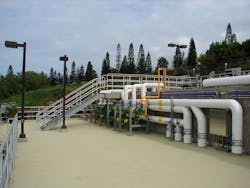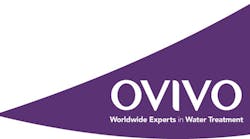Nestled in a valley between the Pukalani Country Club’s golf course and a surrounding residential community in Maui, Hawaii, is the Pukalani MBR Water Reuse Facility, a state-of-the-art membrane bioreactor system (MBR) producing R-1 water reused to irrigate the golf course.
Prior to its startup in October 2010, the Pukalani STP was in a state of serious disrepair. The concentric circular steel tank was in such poor condition that the design and construction of the MBR was fast-tracked to ensure treatment was not interrupted.
Hawaii Water Service Co. solicited bids from several engineering firms for design services in March 2009. Their selection committee chose Water Works Eng. (WWE) of California. At the end of April, the design team held a project kickoff meeting at which WWE presented its 30% design.
The design team included operators and management from Hawaii Water, Water Works and Ovivo (formerly Enviroquip). A project manager also was chosen to represent California Water. Weekly conference calls with the team kept the project moving, and within five months, the project was out for construction bids.
A very limited site drove the design configuration and construction sequence for the plant. The 460,000-gal-per-day MBR had to fit into the area allotted to a future 66-ft diameter concentric circular package plant. While a creative layout permitted the MBR to fit into the small space, Bodell Construction needed to be just as creative in its sequence of construction. With little room to mobilize, Bodell was still able to construct the MBR in less than 10 months.
The plant was designed to exceed Hawaii’s R-1 water reuse limits. Although there are no nitrogen limits on the island, the MBR is designed to meet a total nitrogen effluent of less than 10 mg/L. Aside from the great quality effluent, there are other benefits. The MBR has improved the efficiency of the belt filter press, which produces 17% to 18% cake, and dropped polymer use by 50%.
It is Hawaii Water’s philosophy to standardize MBR designs. Equipment manufacturers, controls systems, layouts and process design will be standardized as much as possible to alleviate the need for multiple sets of critical spare parts. Standardizing these systems also will allow Hawaii Water to increase the learning curve of new operators who will be able to train and operate at another plant before taking over a new plant. Startup, design, construction and training time will be reduced as the team gains experience from multiple projects. Hawaii Water will employ a central location for spare parts.
Although each plant will house some critical spare parts, the central location at Waikaloa will house a more extensive inventory. These spare parts can easily deploy to outlying islands.
The Ovivo MBR Group Staff can be reached at [email protected] or 512.834.6000.



